|
|
| MOVIE SUMMARY: Lavender Hill Mob (1951):
A comedy classic
that benefits from droll scripting (by T.E.B. Clarke , who won an Oscar
for his screenplay), airy direction (by A Fish Called Wanda's
Charles
Crichton) and, most of all, the delightfully eccentric performance of
Alec
Guinness. Here he plays timid bank clerk Henry Holland, who hatches a
scheme
for stealing gold bullion to melt down, cast into small souvenir
replicas
of the Eiffel Tower, and ship to France! But chaos reigns when a group
of English schoolgirls purchase the gold towers, and the gang now
become
embroiled in a wild goose chase to recover their stolen gold. The roles
are perfectly cast, and the acting is uniformly excellent (by the way,
look closely and you'll spot a young Audrey Hepburn in the opening
sequence).
This kind of character-driven comedy, sadly, has all but vanished from
today's movies, but Lavender Hill Mob is a glorious reminder of an
earlier,
much funnier era.
OUR STORY SUMMARY: Lavender Hill Man
(2006): An odonata
classic that benefits from unimaginable hiking (by P. Johnson, who won
a blister for his efforts), airy direction (it is "sort of
that-a-way"),
and, most of all, the delightful eccentric performance by Argia hinei.
Here it plays the timid tiny damselfly that hatches a scheme to extend
its range way northwards — beyond the spell of the L.A. Dodgers and
into
the reach of the S.F. Giants baseball team — thereby casting the field
guides range maps into the dust bin. But chaos reigns when a group of
A.
hinei goes further astray, embroiling mad scientists in a wild goose
chase
to recover the evidence that they exist in Fresno County. The roles are
perfectly cast, and the acting is uniformly bad (by the way, look
closely
and you'll spot a young Rita Carratello in the mid-distance). This kind
of character-driven oding is, sadly, all by vanished from today's
scene,
but Lavender Hill Man is a semi-glorious remake of an earlier, and much
more serious, net-toting era.
|
|
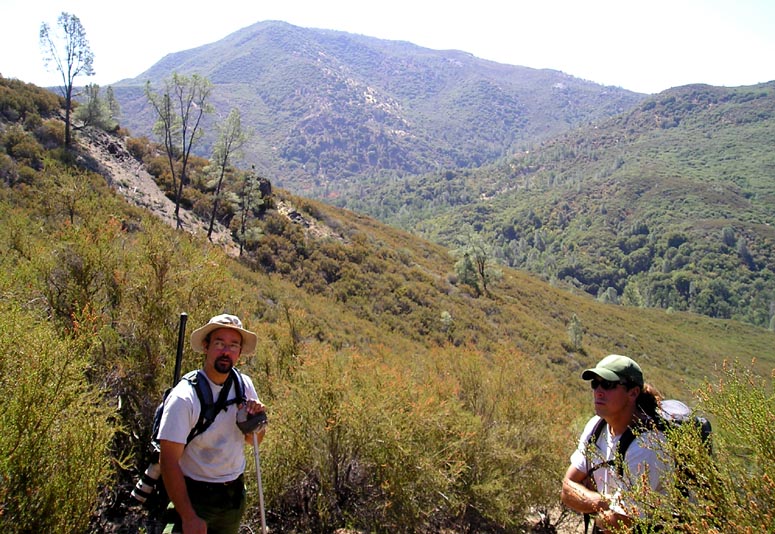
|
|
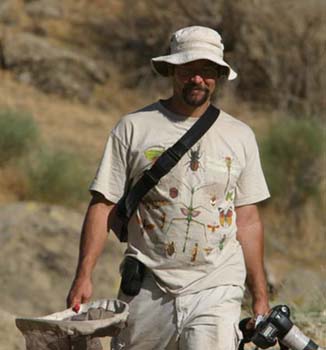 The
star of this screwball story is college-educated (and therefore should
know better) Paul Johnson, eccentric naturalist at Pinnacles National
Monument.
In fall 2005, he had discovered Lavender Dancers at a site on the San
Benito
River in San Benito County (which, it is worth noting, was a part of
Monterey
County until 1874, just a short 132 years ago), and faced with a
skeptical
scientific community, collected that little beast as proof. Later that
year he found more of them on Laguna Creek. He returned there the next
September [photo above; Paul (left) and intern Rob contemplate the hike
to come]. The locale is at the base of Laguna Mountain (in the far
distance,
above), along Laguna Creek (in the fold at the base of the mountain)
and
requires first a 500' climb to a ridge (the photo above) and then a
1000'
drop to the creek (and eventual return up that same way in the 100
degree
afternoon heat). As it happens, the photo crew declined the invitation
to continue farther after making the first climb to the first ridge and
fainting with heat stroke. We are told that Paul and Rob ventured on. The
star of this screwball story is college-educated (and therefore should
know better) Paul Johnson, eccentric naturalist at Pinnacles National
Monument.
In fall 2005, he had discovered Lavender Dancers at a site on the San
Benito
River in San Benito County (which, it is worth noting, was a part of
Monterey
County until 1874, just a short 132 years ago), and faced with a
skeptical
scientific community, collected that little beast as proof. Later that
year he found more of them on Laguna Creek. He returned there the next
September [photo above; Paul (left) and intern Rob contemplate the hike
to come]. The locale is at the base of Laguna Mountain (in the far
distance,
above), along Laguna Creek (in the fold at the base of the mountain)
and
requires first a 500' climb to a ridge (the photo above) and then a
1000'
drop to the creek (and eventual return up that same way in the 100
degree
afternoon heat). As it happens, the photo crew declined the invitation
to continue farther after making the first climb to the first ridge and
fainting with heat stroke. We are told that Paul and Rob ventured on.
But Paul Johnson did not stop there, and within days he was
spotted
wandering an equally remote creek in western Fresno County (photo
right),
with camera and net in hand.
|
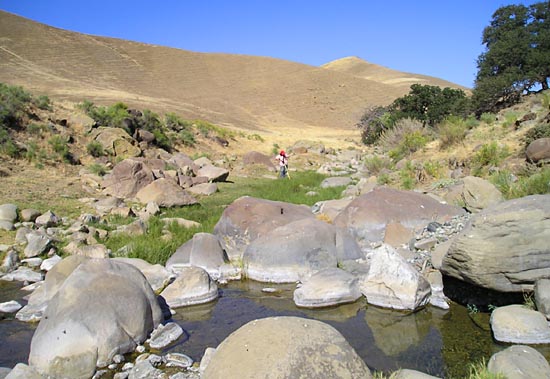 The
creek in question is Arroyo Leona, near the confluence with Cantua
Creek,
and both a long way from anywhere. One supposed that Mendota is the
nearest
town but "near" is not an appropriate term. This is actually the middle
of no where. Here, by special permission on a private ranch otherwise
overrun
with gun-toting cowboys, one may poke along a little permanent creek
(left)
fequented by frogs and garter snakes. Remarkably, among the boulders
and
tule, there lurked yet another population of Argia hinei, the
Lavender
Dancer, establishing the northernmost record for the Great State of
California. The
creek in question is Arroyo Leona, near the confluence with Cantua
Creek,
and both a long way from anywhere. One supposed that Mendota is the
nearest
town but "near" is not an appropriate term. This is actually the middle
of no where. Here, by special permission on a private ranch otherwise
overrun
with gun-toting cowboys, one may poke along a little permanent creek
(left)
fequented by frogs and garter snakes. Remarkably, among the boulders
and
tule, there lurked yet another population of Argia hinei, the
Lavender
Dancer, establishing the northernmost record for the Great State of
California. |
| Taking its turn of the red carpet, A. hinei
(right and
below) proved to be gloriously costumed in shades of pale lavender,
powder
blue, and white. Although very much a tiny slip of thing, it showed
well
in the spotlights and might have been the best-dressed dancer along the
narrow creek bed, which otherwise teemed with A. agrioides, A.
vivida, A. lugens, and other wannabees. |
|
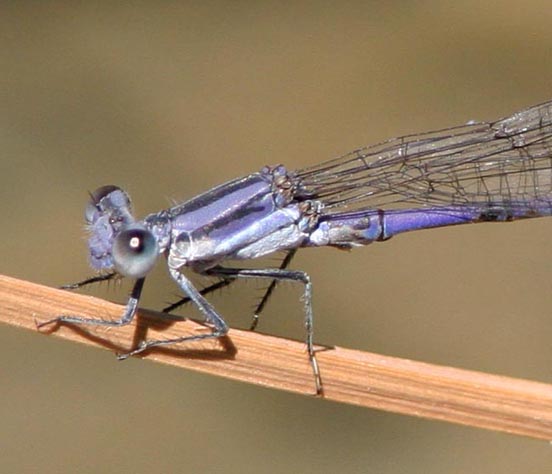 |
|

|
| Manolis (2002) portrayed the previously known range of
Lavender Dancer
like this: "This is a species of the American Southwest and northern
Mexico.
In California, it is found only from Santa Barbara and Ventura counties
southward, on coastal slope of the southern California mountain ranges." |
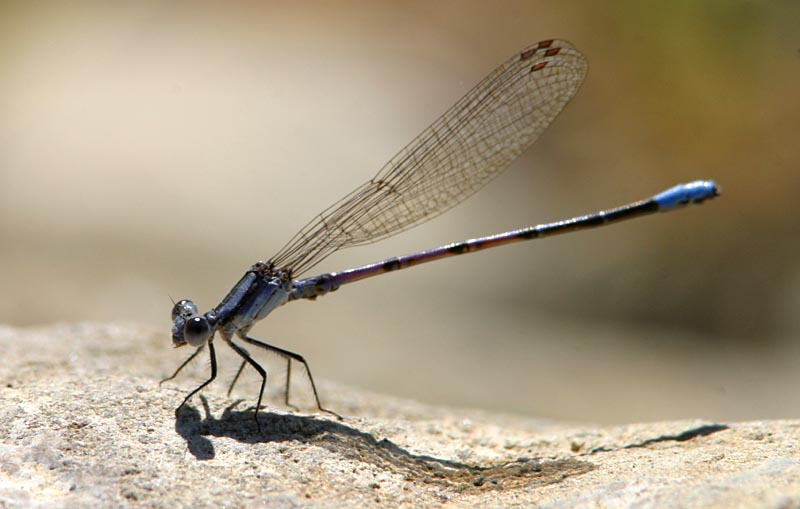
|
| The discoveries by the Lavender Hill Man push the range
a fair bit
northward, and along the slopes of the eastern portions of the Diablo
Range.
In comparison to other dancers sharing the same creek, and especially
California
Dancer A. agrioides, it is a very timid and nonassertive
species,
decidedly smaller, more delicate, and with a quite different 'jizz' (to
borrow a 'birding' term). It is also quite flighty, seemingly unwilling
to stay at any one spot for very long, so these shots are almost
serendipitous.
The naughty bits were fuzzily captured on film, but cannot be shown in
this family story. |
|
Literature cited:
-
Manolis, T. 2002. Dragonflies and Damselflies of California. Univ. of
Calif.
Press, Berkeley.
|
| PHOTOS: All photos are © 2006 Don Roberson; all
rights
reserved.
TOP
TO
PORTAL
PAGE OF DON'S ODONates
TO BIRD
FAMILIES
OF THE WORLD
TO MONTEREY
COUNTY
PAGE
TO HOME
PAGE
|